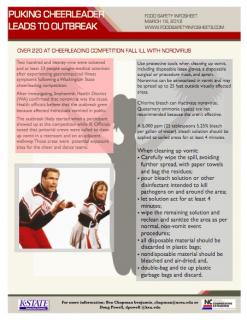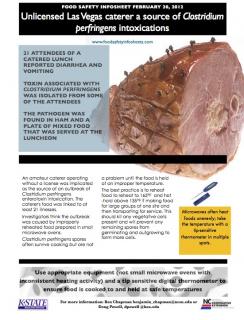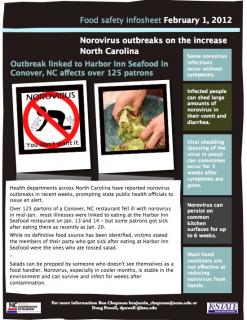Food Safety Infosheet Highlights:
– Handwashing after handling animals, even cute ones, reduces risk of illness. Children can get sick by touching birds and then putting their hands directly in their mouths or touching food.
– Eggs can carry Salmonella and need to be cooked to 145°F for 15 seconds to reduce risk, or until the yolk sets.
– Raw shell eggs should be stored in the refrigerator held at or below 45°F.
– Use pasteurized eggs as a replacement in raw egg dishes to reduce risks.
Puking cheerleader leads to outbreak

Food Safety Infosheet Highlights:
– Over 220 at cheerleading competition fall ill with norovirus
– The outbreak likely started when a participant showed up at the competition while ill.
– Health officials believe that the outbreak grew because affected individuals vomited in public.
– Chlorine bleach can inactivate norovirus; Quaternary ammonia (quats) are not recommended because the aren’t effective.
– A 5,000 ppm (25 tablespoons 5.25% bleach per gallon of water). bleach solution should be applied to soiled areas for at least 4 minutes.
New Food Safety Infosheet: Unlicensed Las Vegas caterer a source of Clostridium perfringens intoxications*

– 21 attendees of a catered lunch reported diarrhea and vomiting
– Toxin associated with Clostridium perfringens was isolated from some of the attendees
– The pathogen was found in ham and a plate of mixed food that was served at the luncheon
– Microwaves often heat foods unevenly making take the temperature with a tip-sensitive thermometer in multiple spots
Outbreak linked to Harbor Inn Seafood in Conover, NC affects over 125 patrons

Food Safety Infosheet Highlights:
– Norovirus outbreaks on the increase North Carolina
– Infected people can shed large amounts of norovirus in their vomit and diarrhea.
– Norovirus can persist on common kitchen surfaces for up to 6 weeks.
– Most hand sanitizers are not effective at reducing norovirus from hands.
Outbreak linked to cross-contamination and ill staff: Raw chicken was washed in the same sink as lettuce
Food Safety Infosheet Highlights:
– 75 ill with salmonellosis after eating at the Tenth Hole Tea Rooms in Southsea (U.K.)
– Salmonella found in pre-cooked pasta and dishcloths, staff tested positive
– Don’t wash raw meats. Salmonella and other bugs can be sprayed up to 3 feet away by washing.
CDC: Romaine lettuce linked by to October and November E. coli O157 outbreak in midwest
– 60 illnesses in 10 states linked to the outbreak; 37 ill in Missouri
– Outbreak has been linked to romaine lettuce; many ill individuals consumed the lettuce at Schnucks grocery store outlets in the St. Louis area
– Fresh produce is not cooked, so any poop that comes in contact with it from farm-to-fork can be passed to diners.
High-end grocery store closed over insect infestation
Food Safety Infosheet Highlights:
– Pest control in the food business is important; be extra vigilant with hygiene and storage practices
– Don’t just employ temporary measures to eliminate the pests; spend time to correct the reasons behind the infestation.
– Holidays are often time of year when large quantities of food will be bought in bulk resulting in additional places for pests to hide.
Server with Hepatitis A at Cheddar’s Casual Cafe results in thousands of vaccinations
Infosheet highlights:
– An estimated 7,700 diners may have been exposed to Hepatitis A in Texas
– Servers while not traditionally thought as food handlers are often involved with scooping beverage ice and salad prep
– Handwashing can reduce the chance of passing on Hepatitis A to patrons. Keep poop off your hands.
Cantaloupes linked to fatal multi-state Listeria monocytogenes outbreak
– 4 deaths and 15 illnesses in Colorado, Nebraska, Oklahoma and Texas.
– Listeria monocytogenes can grow slowly at refrigeration temperatures in some foods including cantaloupe. Listeria on cut cantaloupe will only reach levels likely to cause illness after many days of storage at 41°F.
– Refrigerate cantaloupes quickly after slicing. Bacteria such as Listeria can grow quickly on the orange flesh of the fruit when held above 41°F.
– Ask suppliers about food safety risk-reduction practices including how they manage water, animal exclusion and staff.
Recovering from a storm: home garden flooding
Infosheet Highlights:
– Flooding can lead to increased food safety risks associated with garden-grown produce.
– Flood waters can contain pathogens and toxins; if a garden has been submerged by flooding it is possible that human pathogens have been introduced into the system.
